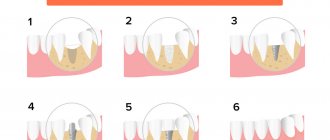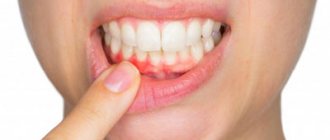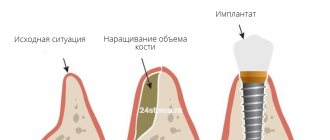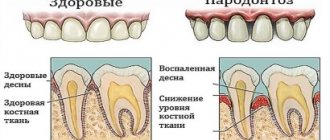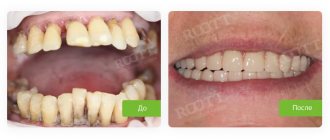Our teeth do not forgive careless treatment. Advanced caries leads to pulpitis, and from there it is not far to tooth extraction. If you do not solve the problem of gaps in the dentition for a long time, then you will inevitably face an irreversible process of atrophy of the jaw bone.
What is this process and why does it happen? The human body operates according to a very simple principle: “he who does not work, does not eat.” If for any reason an organ stops functioning, the body stops supplying it with the necessary substances in full and the organ begins to atrophy (decrease in size).
The jawbone is no exception: while it is experiencing chewing load, the body diligently “feeds” it and maintains it in working condition. An extracted tooth deprives the jawbone of its normal work: immediately after the loss of a tooth, the bone begins to adapt to new circumstances.
The process of jaw bone atrophy can be divided into two stages. First, a thin strip of bone disappears, which was closest to the roots of the extracted tooth: such a restructuring takes one and a half to two months. It takes a few more months for the bone to heal. If after this stage you do not give the bone chewing load, the bone tissue begins to gradually dissolve further. The process of atrophy affects deeper and deeper layers. In a year of missing a tooth, the volume of the jawbone can decrease by up to 25%.
Tooth loss is the most common cause of bone loss, but it is far from the only one. Atrophy is also caused by:
- Inflammatory diseases of the mouth, such as periodontal disease, granulomas, and cysts;
- Deterioration of blood supply to the bone (this is affected by age-related changes, diseases of the cardiovascular system, endocrine pathologies);
- Various malocclusions and jaw injuries.
Prosthetics based only on gums (removable) or on living teeth (bridge) do not solve the problem: the jawbone under such dentures does not experience the necessary pressure and the process of bone tissue atrophy continues.
How to understand that tissue atrophy is occurring?
- the patient’s face “sinks,” the skin in the jaw area sags, nasolabial wrinkles become more pronounced;
- the gum contour recedes;
- displacement of dental units occurs;
- neighboring crowns become more mobile.
In dental practice, there are four main types of bone atrophy: minor, moderate, pronounced, and severe atrophy of bone tissue. So, with minor atrophy, implantologists can still introduce a titanium root into the jaw without restoring the bone, but with a rough form, they cannot do without restoring the volume.
The main causes of bone tissue atrophy in a patient
- missing one or more teeth;
- wearing prosthetic systems that apply pressure;
- jaw deformation;
- cystic formations on the roots - pathological cyst cells grow and gradually replace tissue;
- anatomical feature of the jaw structure;
- elderly age;
- diseases (diabetes mellitus, osteoporosis, gum disease, inflammatory processes in the oral cavity);
- incorrect prosthetics or implantation.
When chewing food, pressure is applied to the bone, and it, one way or another, dissolves. If the pressure itself cannot be excluded, then there is always the possibility of returning the lost bone with the subsequent installation of a dental prosthesis or bridge.
Comparison of characteristic symptoms of two pathologies
How these diseases differ from each other can be judged from the table.
At the initial stage
| Periodontitis | Periodontal disease |
|
|
In the middle stage
| Periodontitis | Periodontal disease |
|
|
At a severe (advanced) stage
With periodontal disease at this stage, bone tissue atrophy reaches 2/3 of the height of the roots, the teeth cannot be held in place - mobility occurs, the roots are exposed by 6 mm or more, pain increases while eating, even to the point of refusing to eat and oral hygiene in order to do not cause pain, dental units look unattractive - visually large crowns and narrow elongated roots violate the aesthetics of a smile.
The following symptoms occur with periodontitis:
- gums can be either inflamed and swollen, or pale due to lack of nutrition,
- severe pain with any impact, even with tongue movements and conversation,
- there is burning and itching,
- suppuration intensifies, pus is contained in large quantities under the gums,
- plaque and stone surround the tooth on all sides, fill periodontal pockets,
- periodontal pockets reach 5 mm or more,
- Pathological mobility of teeth occurs (grades II and III), when the teeth deviate not only to the sides, but also up and down by a distance of more than 1 mm, and can rotate around their axis. Often they are held in the holes only by accumulated stone,
- the root of the tooth is exposed more than half of its height,
- bone tissue declines catastrophically, its level has dropped to half the height of the root,
- teeth have nothing to hold on to - they begin to fall out,
- Traumatic occlusion occurs (closing of the jaws), malocclusion due to the loss of individual units.
Important! At the last stage, periodontitis can take on an acute form, when all the symptoms sharply intensify. Then patients experience fever, increased body temperature, severe pain and suppuration. All this affects both a person’s physical well-being and his psychological state - many people experience stress and depression due to problems in the oral cavity very acutely.
In this case, periodontitis can (though quite rarely) develop locally in one area or be generalized - widespread throughout the entire oral cavity. Periodontal disease is always a generalized form, when the disease affects both dentitions, and not individual units.
In addition to destruction in the oral cavity, the disease harms the entire body, affecting the functioning of internal organs. It has consequences for many systems and organs, no less dangerous than itself.
What happens if bone tissue atrophy is not stopped?
The quality of life, appearance, and feelings of a person are more influenced not by the resorption itself, but by the causes of the problem. For example, if the bone in the jaw dissolves due to the absence of one or more teeth, the process of chewing food is disrupted, an imperfect food bolus is formed, resulting in problems in the functioning of the gastrointestinal tract. Diction is also impaired, facial asymmetry occurs, and psychological discomfort develops due to the lack of teeth. The teeth begin to shift in the direction where one or a group of teeth is missing.
It is important!
The longer the jaw is missing teeth, the more volume of jawbone is lost, and the more of it will need to be built up in the future during implantation. Timely replacement of a lost tooth with an implant that serves as a support for the prosthesis will prevent atrophy and will also help save your budget (you will not need to perform an expensive operation to restore the bone).
Expert opinion
Emir Romanovich Omerelli
Maxillofacial surgeon, implantologist
Experience: more than 13 years
It has been proven that maximum atrophy of bone tissue occurs in the first year after tooth loss, and begins already three months after tooth loss, so you cannot delay dental prosthetics. The fact is that the lack of just one tooth in the jaw often causes quite serious problems. Each tooth performs its own function. The absence of even one tooth leads to disruption of chewing function, and can cause diseases or exacerbations of diseases of the digestive system, periodontitis, traumatic occlusion, displacement of the remaining teeth into free space, aesthetic defects, changes in speech, deterioration of the condition of the teeth, making subsequent prosthetics difficult.
How to solve the problem of bone tissue atrophy?
- Perform a sinus lift - a procedure for increasing bone in the upper jaw. In this case, the maxillary sinus may rise or shift to free up jaw space for new bone.
- Bone grafting is an operation in which the lack of bone is filled with artificial synthetic materials. The operation is often associated with the risk of rejection of the artificial material.
- Bone grafting is a technique of transplanting your own bone blocks from one area of the jaw to another. As a rule, bone material is taken from the area of the “eights” (wisdom teeth) and placed in place of the bone deficiency. Due to the natural nature of the material, the risk of rejection is low.
To prevent jawbone atrophy, it is important to provide comprehensive prevention. So, if a tooth falls out or is removed, replace it in a timely manner with a new titanium root, which serves as a support for the crown.
Also, for a patient whose tooth has been extracted, a special membrane is placed in place of the gap to prevent atrophy. If necessary, a small amount of tissue is added to the internal compartment to replenish the lost volume and ensure the stability of the implant being introduced.
Classic delayed load protocol
Classic surgery is performed when there is sufficient bone tissue (at least 10 mm) in two stages. The protocol involves delayed loading on the implants: they need time to fuse with the jaw.
An implant with dismountable elements (an abutment and an intraosseous part) is fixed using the method of detaching a gum flap - the gum is cut and sutured.
2-6 months after the operation, the implant is opened, a gum former is placed on it, and two weeks later - an abutment and an individual permanent prosthesis.
1
Implantation
Implantation
2
Prosthetics
Installation of a butterfly prosthesis or temporary crown (if it is possible to remove the bite)
4-6 months
Installation of abutment and permanent crown
Osteoplasty in case of a lack of tissue is organized before the implantation of titanium roots or simultaneously. The operation is justified for single defects. If the patient has multiple defects or complete edentia, classical surgery is difficult due to acute bone loss and the need to build up a large volume of bone.
If there is not enough bone tissue for implantation, classical implants in some clinics are implanted without tissue augmentation. The doctor suggests:
- install titanium roots only in the frontal zone (signs of atrophy rarely appear here);
- fix the implant in the area of the posterior wall of the maxillary sinus at the end of the dentition, behind the maxillary sinus (the height of the bone here reaches 20 mm);
- implant short and thin implants - implantation is possible in case of atrophy of the bone tissue of the lower jaw, without touching the jaw nerve.
But the described methods are unreliable: the risk of weak primary stability of the implant and its loosening cannot be excluded. The most reliable method in case of severe atrophy of bone tissue in the upper jaw can be pterygoid implants
ROOTT. These implants are longer than classic ones and are implanted into the zygomatic bone, bypassing the maxillary sinuses. Pterygoid implantation differs from zygomatic zygomatic implantation in its safety and low trauma.
When performing an operation, it is important to use implants from the same manufacturer (with the same impurities - metals in a titanium alloy). When fixing implants, impurity metals of different brands in the acidic environment of the oral cavity may not combine and cause allergies, galvanic syndrome, and rejection of titanium roots. The ROOTT implant system is unique: a range of implants from one manufacturer is used in all clinical cases.
Why doesn’t prosthetics solve the problem of bone tissue atrophy?
Installing a removable denture or “bridge” does not solve the issue of missing bone, since the load in this case is on the gum tissue and on the remaining healthy teeth. Consequently, the resorption process is not stopped, the gums begin to “sag” along with the bone, the fixation of the prosthesis is disrupted, and a gap is formed under it. Food debris accumulates in this gap, which can lead to inflammation. Unlike conventional prosthetics, dental implantation allows you to compensate for the deficiency of bone tissue, and most importantly, restores the integrity of the dentition.
Prognosis after treatment
The optimal treatment option is when the implant is installed in the existing bone volume and bone chips are immediately attached to it. In this case, the prognosis is favorable, because the bone will be restored and at the same time grow onto the support – the implant. If the implant is placed 6-12 months after the extension, then in 40-60% of cases it is discovered that the implanted material has taken root poorly and its volume is not enough for implantation. The extension operation has to be done again, and even more than once. And in some patients, after several unsuccessful osteoplastic operations, the alveolar ridge becomes so thin that they can only wear removable dentures.
[1] Ushakov A.I. Dental implantation and selection of osteoplastic materials depending on the type of bone tissue of the jaws, 2016.
Author: Bespalov R. D. (Thank you for your help in writing the article and the information provided)
Implantation options for bone atrophy
- Dental implantation with delayed loading is a technique in which bone material is first restored, and only then an artificial implant is introduced - a support for the subsequent prosthetic structure.
- Dental implantation with immediate loading is a procedure in which the implant is screwed into the basal (deep) parts of the jawbone, and not into the alveolar zone, as with classic implantation with build-up. In this case, the bone is instantly “loaded”, all living cell processes are preserved in it, and healing is accelerated.
How much does surgery to restore bone atrophy cost?
The average price of bone grafting in Moscow is from 20,000 rubles. The cost of a sinus lift ranges from 22 thousand to 80 thousand rubles, respectively.
This amount includes expenses for:
- osteoplastic materials;
- bone membrane;
- anesthesia;
- X-ray images;
- the work of a surgeon, etc.
Dentistry "32 Dent" specializes in performing bone grafting operations to solve the problem of bone tissue resorption in patients and the restoration of living cells. Also, specialists will restore the dentition by performing subsequent prosthetics.
If you have a problem similar to that described in this article, be sure to contact our specialists. Don't diagnose yourself!
Why you should call us now:
- We will answer all your questions in 3 minutes
- Free consultation
- The average work experience of doctors is 12 years
- Convenient location of clinics
Single contact phone number: +7
Make an appointment
Sources:
- Personal experience as an orthopedic dentist;
- Yamurkova, N. F. Optimization of surgical treatment for severe atrophy of the alveolar process of the upper jaw and the alveolar part of the lower jaw before dental implantation: abstract. dis. ...Dr. medical sciences: 01/14/14 / Yamurkova Nina Fedorovna. — Nizhny Novgorod, 2015;
- Durnovo, E.A. Method of preserving alveolar tissue in the aesthetically significant zone / E.A. Durnovo, A.V. Kazakov, S.E. Sakharova, N.A. Yanova // Russian Bulletin of Dental Implantology. – 2013;
- Amkhadova, M.A. Surgical tactics when using the implantation method in patients with dentition defects and significant jaw atrophy: dis. ...Dr. med. Sciences: 14.00.21 / Amkhadova Malkan Abdrashidovna. – M., 2005;
- Artyushkevich, A.S. Periodontal diseases: a practical guide / A.S. Artyushkevich. – M.: Med. lit., 2006;
- Bedretdinov, R. M. Clinical and morphological assessment of various osteoplastic operations before dental implantation (experimental clinical study): abstract. dis. Ph.D. medical sciences: 01/14/14 / Bedretdinov Rinat Mansurovich. – M., 2016;
- Belchenko, V.A. Craniofacial surgery: a guide for doctors / V.A. Belchenko. – M.: Medical Information Agency., 2006;
- Andersson, L. Oral and Maxillofacial surgery / L. Andersson, K. Kahnberg, M. Pogrel. – WILEY-BLACKWELL Publishing Ltd. – 2010;
- Alfaro, F.H. Bone grafting in Oral Implantology. Techniques and Clinical Applications / FH Alfaro. – Quintessence Publishing Co. Ltd. – 2006.




